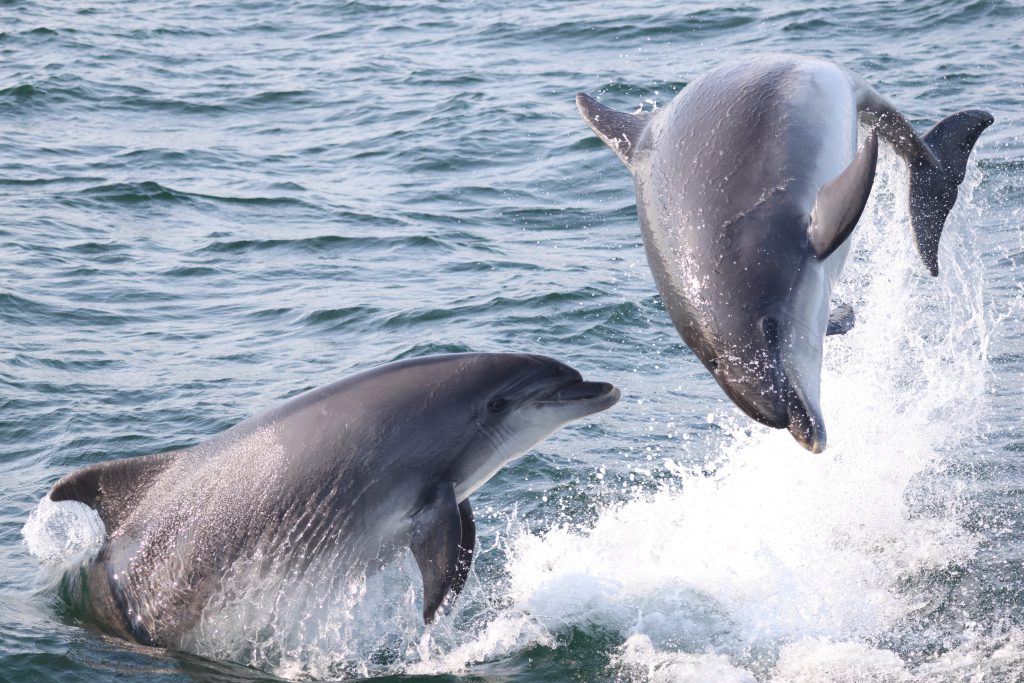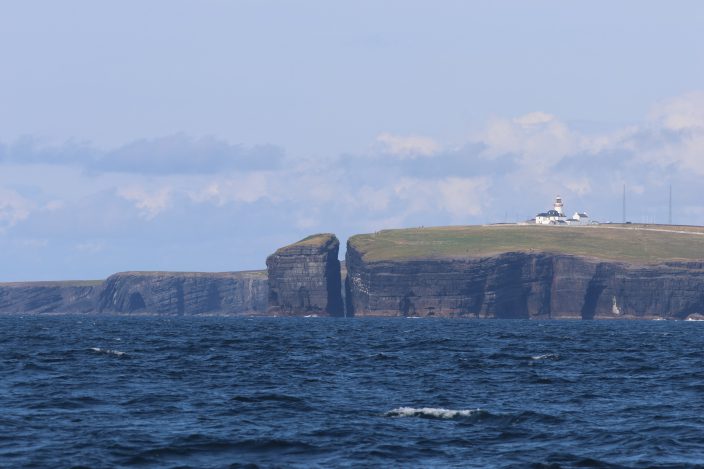
Rossaveal to Kilrush
Crew: skipper Pat, first mate Colm, marine biologist Hélène, second marine biologist Kim, Emma, Orna & Sébastien
Leg 9 of the Celtic Mist itinerary 2024 started off with a message from Celtic Mist officer Andrew about a week before the planned departure: “The cruise may not go through, we have no skipper. We are working on finding one and will get back to you few days in advance.” Everyone waited in agony, having looked forward to spending time on the vessel and exploring the Irish West Coast starting in Rossaveel, passing the Aran Islands, the Cliffs of Moher, Mutton Island, the Kilkee Cliffs and finally entering the Shannon Estuary between Loop Head and Kerry Head on the way down to Kilrush. Luckily, both for the crew and the scientific objectives, a skipper was found in the end, and with a little rush, travel arrangements were made and car pools organized. The group met on Saturday evening in Rossaveel Harbour, got acquainted, and didn’t lose time to prepare the shopping list and head out for groceries. The evening ended with take-out food, the safety briefing and what would be the last showers for three days.
Day 1
Early on Sunday, we departed from Rossaveel with our very first sighting: a harbour seal “waving farewell”. Not long after that, as we headed to pass between Inishmore and Inishmaan, common dolphins approached us from astern. They were shy at first, but then started bow-riding for a little while before leaving us again. The sea conditions were promising good chances for further sightings: calm seas and fine clean skies. After passing between the two of the Aran Islands, just before setting out to deeper waters beyond the 100-metre-contour line, we spotted a sunfish right beside the boat. Although visibility and sea state were favourable, however, we could not spot any marine wildlife besides sea birds for a good while after that. The first non-feathered sighting we had on that stretch was – a bright purple foil balloon. We spun around in a nearly perfect figure-of-eight to collect it and documented it in the database. A second questionable object between a small group of floating sea birds turned out to be a dead and decomposing seal. As we approached the coast again, excitement rose over the breach of a large animal in the distance: it may have been a Minke, however, as we approached it, we could not confirm the species. Beside the dubious splash, we could get sight of a few common dolphins and another sunfish. And then, we were able to observe something very special: groups of basking sharks. One of the groups came past us as we stopped as to not disturb them. It was magical to see the dark triangular fins sticking out the water against an otherwise shimmering sea surface. With great care and keeping a minimum altitude of 12 metres to not disturb them, we recorded the sharks with a small drone and observed them circling in the water and swimming in a triangle formation. It was a group of eight animals. We stayed with them for a while, then continued to finish the transect and start the last one to reach our destination for the night: Inisheer. It was on this track that we spotted two more groups of basking sharks, consisting of five and nine animals that we could see on the surface, respectively. Heading to Inisheer, we recorded a couple of creels (lobster pots), three grey seals, and another balloon. We finished the evening tied up behind the ferries in the harbour of Inisheer.
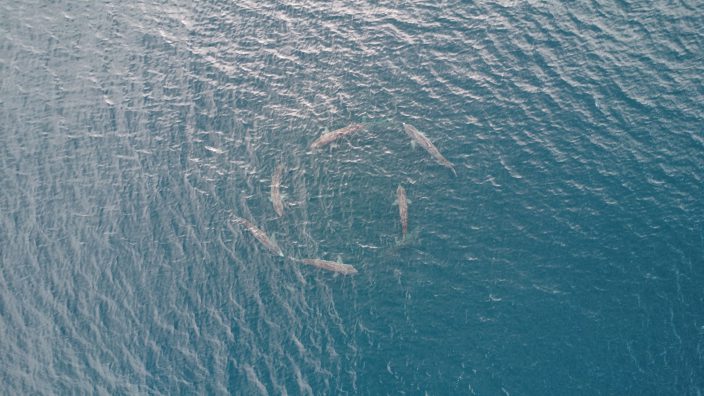
Day 2
We left the island on a clear morning, spotting a seal and some creels before starting our first transect of data recording for the day. Just before leaving the coast to again venture into deeper waters, we had our first sighting of a small group of basking sharks. As we moved offshore, we had little encounters with cetaceans except for a potential harbour porpoise breaching fairly distant from the boat. Only a few common dolphins showed themselves and went bow-riding briefly. As much as we would have liked to see more of them, the fact that there were only very few cetacean encounters did not make this day a waste. To obtain an accurate picture of cetacean occurrences, it is necessary not only to invest effort in areas with frequent sightings, but also to record effort in areas where they were absent. The lack of cetaceans on this day, however, was made up for by the birdlife: baby puffins (as well as adults), dark-coloured sooty shearwaters, and a group of gulls which was following our vessel. Also, we came across a set of creels marked with little black flags in quite deep waters. The conditions were more variable than the day before: from light rain and a cold breeze to sunshine and no wind at all. Since our transects for the day were very long, we had dinner while the watches still continued. Again, it was basking sharks we saw along the coast, three groups in total. Finally, we anchored in a sheltered bay behind Mutton Island and ended the day with playing a round of Quirkle.
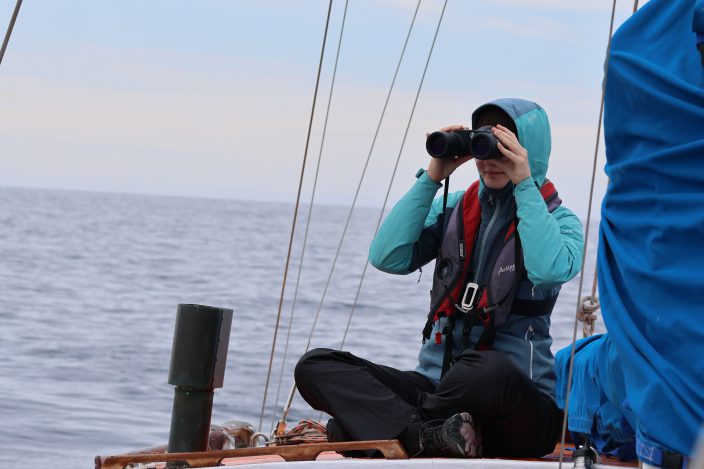
Day 3
The morning started with a skipper swap. Due to the last-minute-skipper arrangements, previous commitments had to be taken care of and so we were joined by a new skipper for the day, who was picked up from Seafield Pier with the dingy and brought two of his sons as day guests. Once breakfast was eaten and everyone ready, we lifted the anchor and headed out of the little bay. Soon after leaving, two pods of bottlenose dolphins appeared and stayed around the boat for a little while – what a treat after a cetacean-poor previous day! We circled around to keep them in sight and try to take some pictures for photo-ID. When they left us, we continued on to the first waypoint to start the first of our transects. As in the two previous days, our aim was to cover a variable depth profile, so we headed out again to reach deeper waters – and again, we recorded basking sharks and a common dolphin when leaving the coast and then no cetaceans or other marine megafauna both on the way out and back in. In contrast to the previous days, however, sea conditions were unfavourable for surveying on this day: the wind had picked up and threw regular white caps on the water surface. Together with the swell, these conditions made it very hard to distinguish cetacean activity from the surrounding sea. On the upside of things, we were able to set the main and mizen sail. When we arrived in the Shannon Estuary, it was not before long that we were joined by a group of Shannon bottlenose dolphins. In the beginning, it was just a small group of animals, but quickly it appeared to grow from all directions, and we were accompanied up the Shannon by varying individuals from the resident bottlenose population, showing a range of behaviours: bow-riding, leaping, feeding, and travelling. They stayed with us for nearly two hours and equipped with two cameras and phones, we were able to get a solid amount of footage for photo-ID. It was a great compensation for the crew after three long days with rather few sightings, and everyone was full of excitement for the rest of that evening. We arrived late in Kilrush, where our skipper for the day and his two boys were picked up again. Since the weather forecast for the next day was not good, we didn’t mind the late arrival. Besides dinner and the desperately needed showers to wash out three days’ worth of sea water and sunscreen, however, our energy for the day was spent.
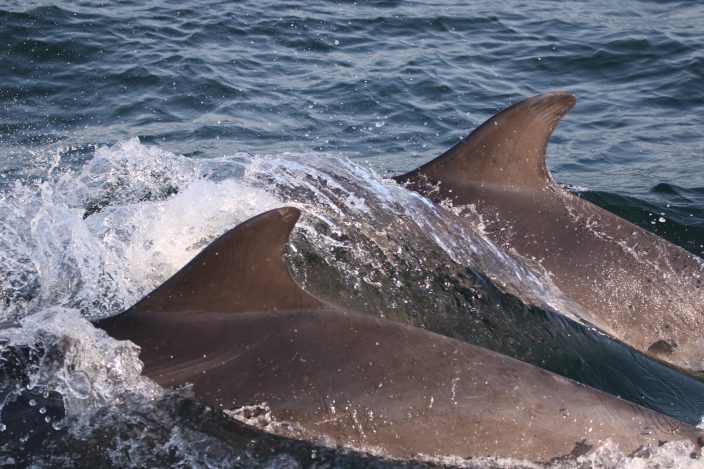
Day 4
We started with a lazy morning after the three long and intense survey days, visited the Shannon Dolphin Centre and the IWDG team there for a chat. When joined by our original skipper, survey opportunities for the afternoon of the same day and for the next one were discussed with the latest weather forecast and the timetable for the local tidal regime at hand. For this day, no good option could be found, and so we spent the day with walks through Kilrush and filling up supplies on the boat: groceries, fuel, water. The mate and skipper carried out checks and some small repairs, the biologists sorted the photo-ID footage from the bottlenose dolphin sightings, and eventually meals for dinner and for next day’s lunch were prepared. The plan for the last survey day of the week was to start very early in the morning, heading out at five a.m. to catch the tidal current out of the estuary and do a last transect out towards 100 metres depth before returning to Kilrush, cleaning Celtic Mist for the next crew and having a dinner out on the last day.
Day 5
Everything started as planned. By half past five, we had left Kilrush Marina via the lock and were on our way out of the estuary. Around that time, we were again joined by a group of five bottlenose dolphins, four of them bow-riding side by side for a short while. They stayed behind after a few minutes and we continued down the river. As we approached the mouth of the Shannon into the Atlantic, however, the visibility was very bad due to mist, rain, and a very high swell. Items started sliding from the counters, including someone’s breakfast scrambled eggs, and it was obvious that a watch would neither be useful nor advisable for safety purposes in these conditions. Therefore, sadly, the call was made to return to port. Although the tide was not in our favour, we managed our way back into the marina and tied off Celtic Mist for the final time on this leg. The rest of the day was used for resting, laundry, cleaning the vessel and packing. As the weather cleared up late in the morning, however, we also were able to enjoy our time on the deck, playing rounds of Quirkle and even were invited for a small sailing session in a keelboat of the local sailing club! Showered and relaxed, we finally went to spend a very nice dinner in Kilrush – a great end to a great experience!
Overall Stats
We spend almost 27 hours on effort (looking for animals) for a total of 42 hours of sailing (380km – more than 200nM). We recorded 43 sightings: majority of common dolphins, bottlenose dolphins, grey seals and basking sharks.
Thanks to the crew for the craic, the Qwirkle competitions and their help during these long survey days, it’s very much appreciated. Without every week‘s crew dedication this survey will not be possible.
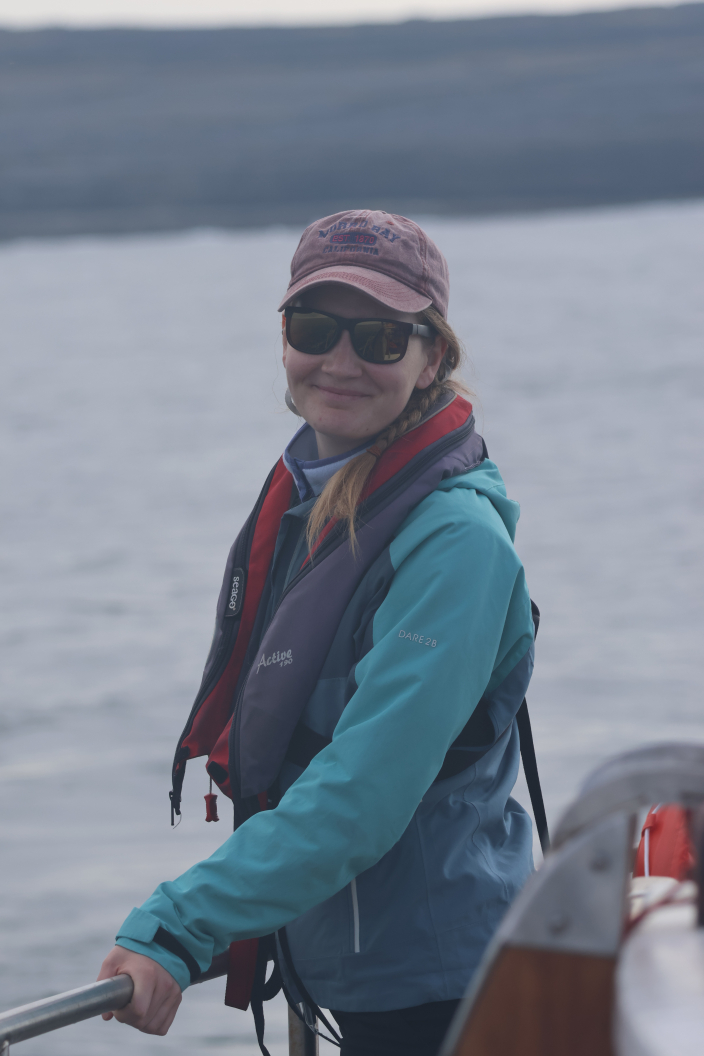
Kim Ludwig
Celtic Mist 2nd Marine Biologuist
????ℎ???????? ???????????????????? s???????????????????????? ???????????? ???????????????????? ???????????? ???????? ???????????????????????????????????????????????????? ????????????ℎ Fair Seas. ???????????????????????? ????ℎ???? ????????????????????????, ???????????????????????? ???????????????? ???????????????? ???????? ???????????????????????????????????? ????ℎ???? ???????????????????????? ???????? ????ℎ???? ???????????????? ???????????????????? ???????? ????????????????????????????, ???????????????????????????????????????? ???????????????????? ???????????????????????????????????????????? ???????? ????ℎ???? ???????????????????????? ???????????????? ???????? ???????????? ????????????????????????.

